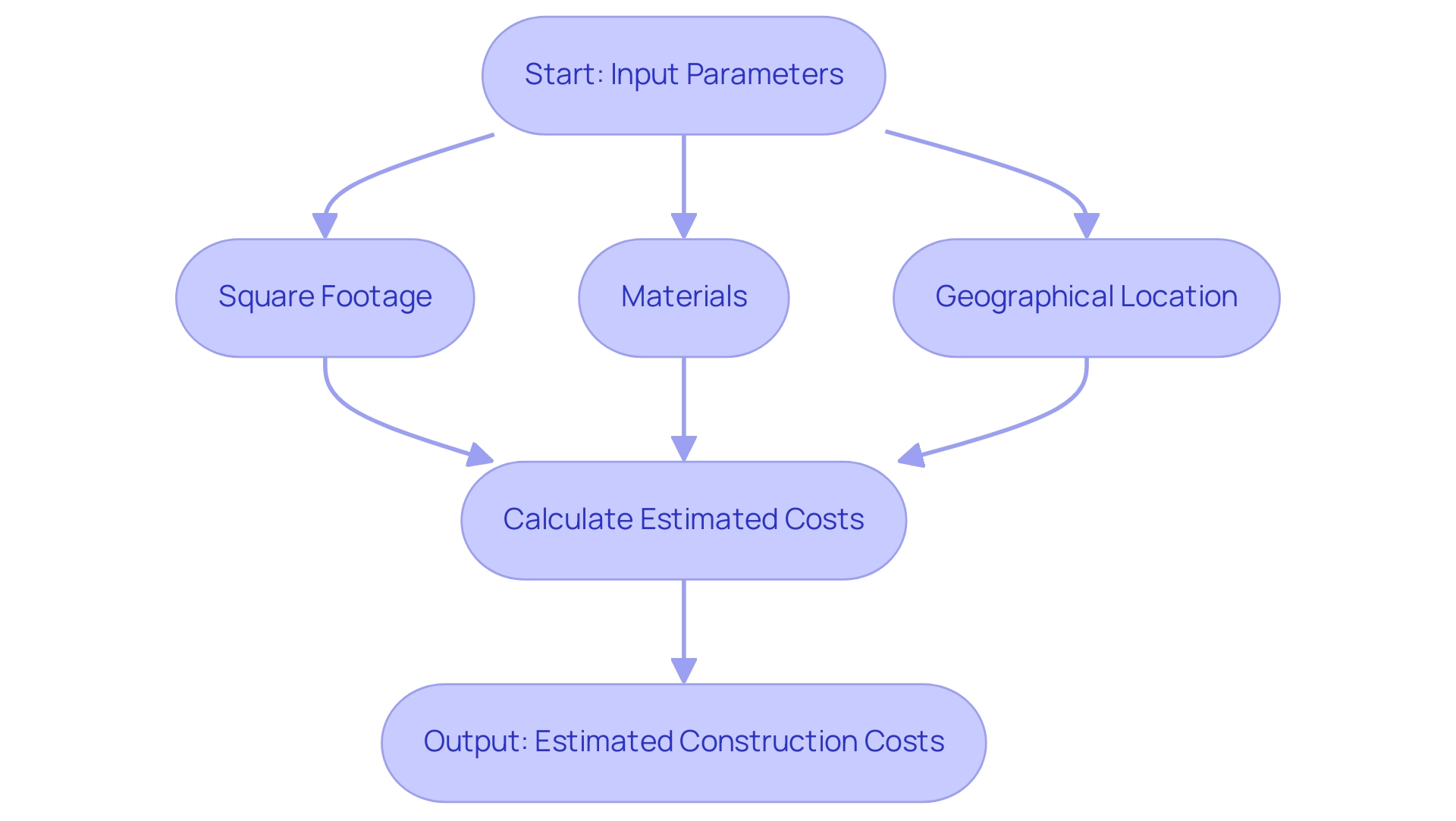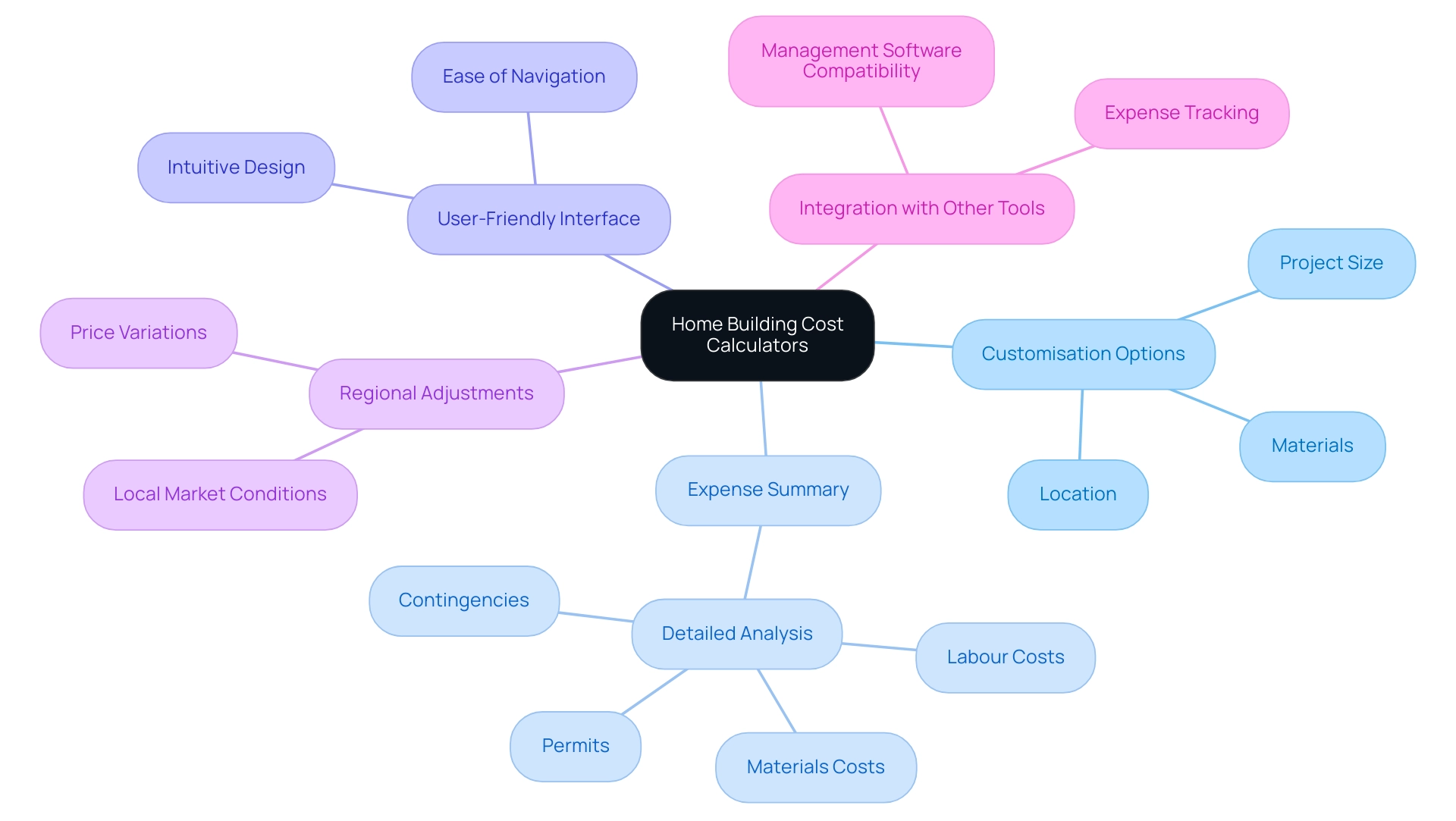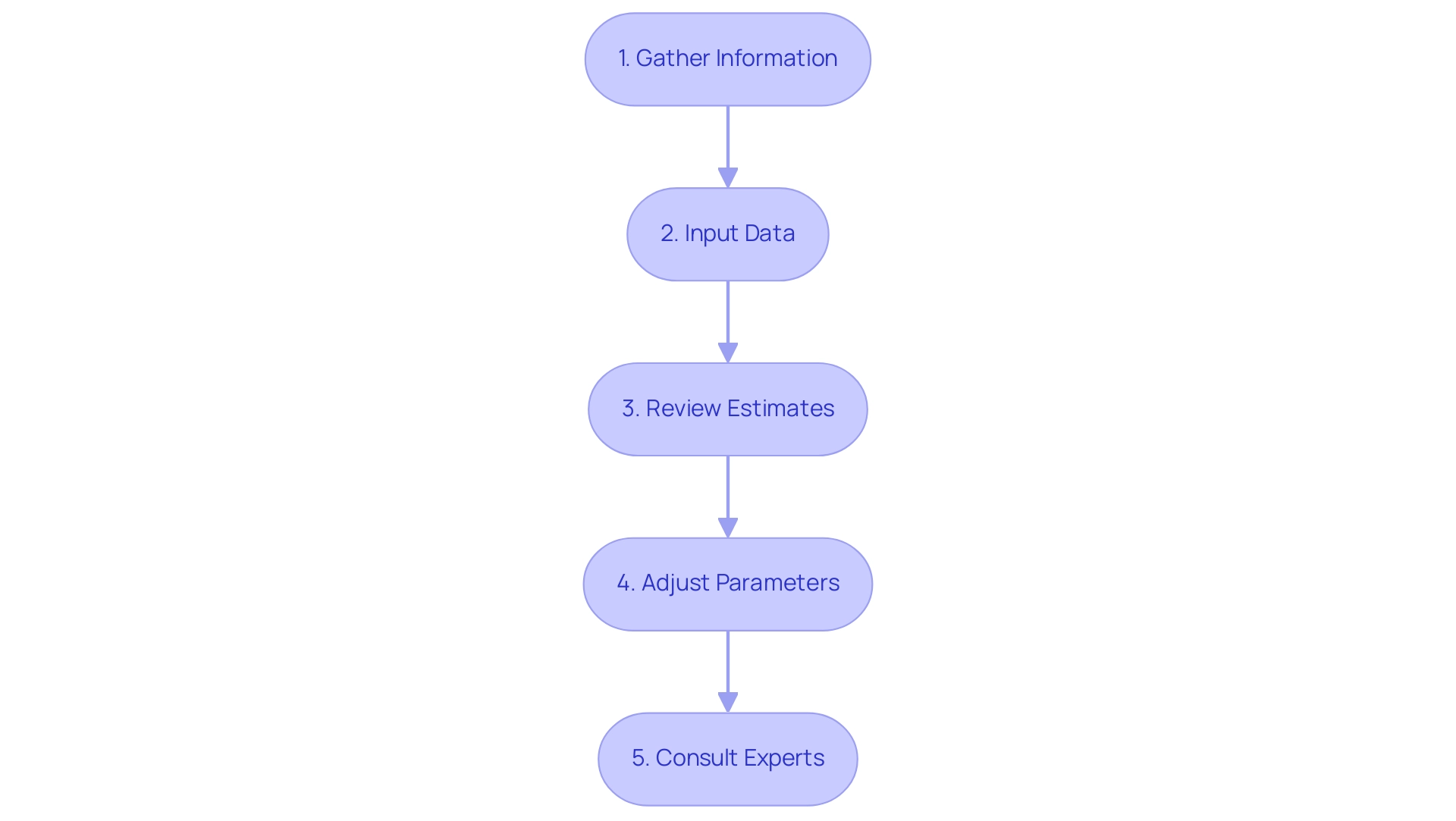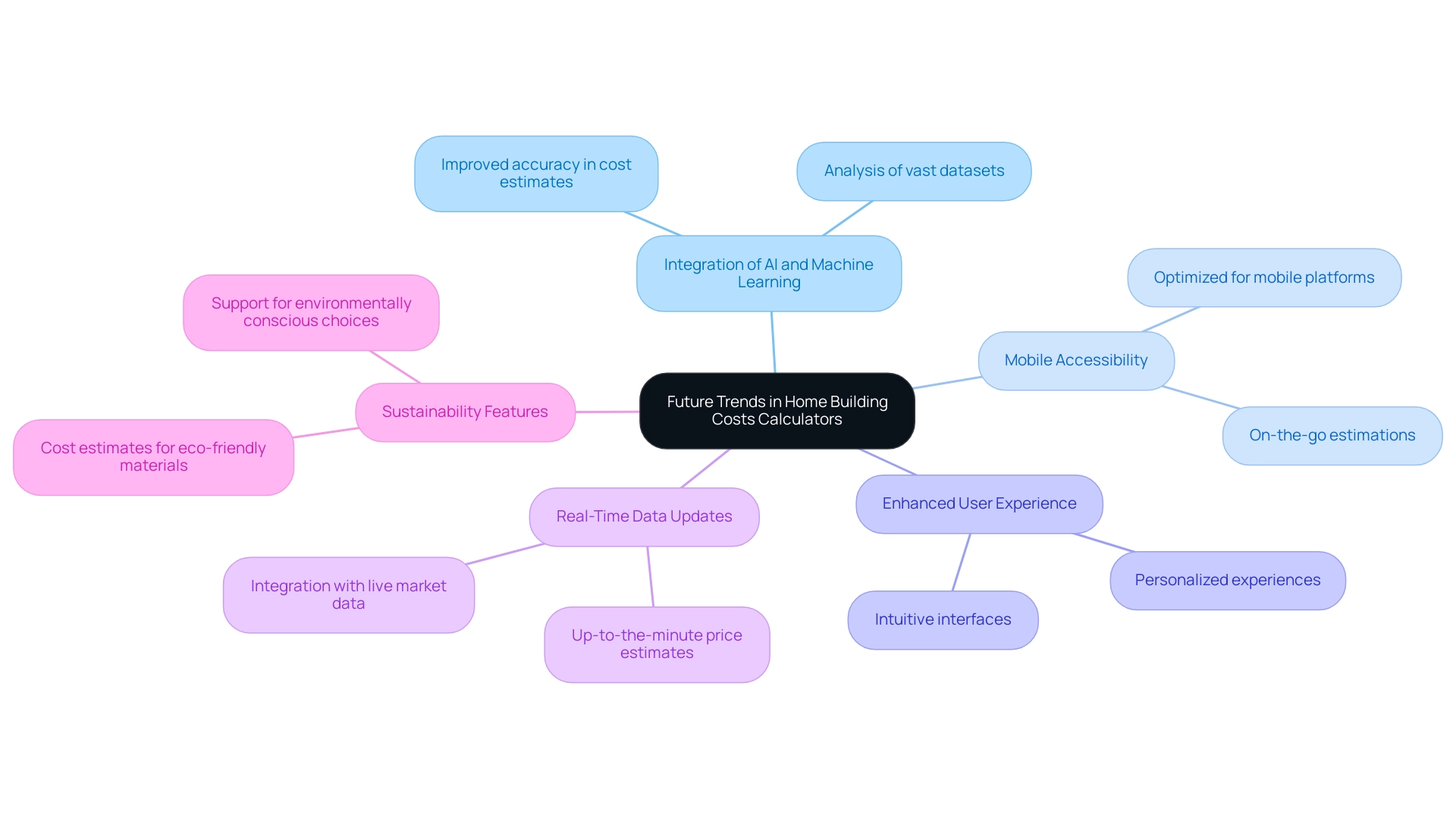29 Mar 2025
BlogOverview
A building costs calculator serves as a vital digital tool that estimates the expenses associated with construction projects. By allowing users to input details such as size, materials, and location, it generates precise budget estimates. This article underscores the calculator’s significance in financial planning for construction projects.
Accurate estimations are crucial; they can prevent budget overruns and delays, ultimately enhancing project success and decision-making efficiency. Understanding the importance of this tool empowers stakeholders to engage in more informed and effective planning.
Introduction
In the dynamic world of construction, the financial implications of building projects demand urgent attention. Building cost calculators have become essential instruments, empowering developers to navigate the complexities of budgeting with remarkable precision. These calculators offer estimates based on various project parameters and assist in identifying potential financial pitfalls early in the planning process. Given that a significant percentage of construction projects encounter budget overruns, utilising these calculators can be the decisive factor between success and failure. As technology continues to advance, the future of these tools promises enhanced accuracy and user-friendliness, equipping stakeholders to make informed decisions in their building endeavors.
Defining Building Costs Calculators: An Overview
A building costs calculator serves as an invaluable digital resource, estimating the costs associated with constructing a house or commercial property. By entering parameters such as square footage, materials, and geographical location, users can obtain an estimated expense for their construction project. This functionality is essential for both homeowners and builders, empowering them to make informed financial decisions early in the planning stages.
These tools exhibit varying degrees of complexity, ranging from straightforward online forms to sophisticated software that accounts for regional price variations and fluctuating material costs. In the UK, approximately 70% of developers utilise construction cost estimators, underscoring their recognition as vital instruments within the construction sector.
The importance of employing a building costs calculator cannot be overstated. These calculators not only provide a preliminary budget but also help identify potential financial pitfalls before construction commences. A recent case study involving a proposed new office block in York, set to begin construction in January 2025 with a gross floor area of 4,000m², exemplifies the meticulous financial planning required.
The indicative total construction works cost was estimated at £12,000,000, excluding land purchase, fees, VAT, and client-supplied fittings. This example illustrates how thorough budgeting can significantly impact the feasibility and success of projects. Moreover, recent data reveals that 99.7% of structures will be priced under £4,880 per square metre, further demonstrating the utility of these tools in establishing realistic expectations.
This statistic holds particular relevance for developers, as it informs their budgeting and planning processes, ensuring competitiveness and financial viability. By providing a clear summary of potential costs, the building costs calculator enhances decision-making and planning, ultimately resulting in more successful outcomes in construction endeavours.
At Edmond Shipway, we acknowledge the critical role that precise expense assessment plays in management and sustainability. Our comprehensive construction advisory services are designed to assist developers in navigating the complexities of construction costs. Leveraging our multi-sector expertise, we offer tailored solutions that enhance the efficiency of construction cost estimators, enabling clients to achieve their objectives while upholding economic efficiency and sustainability. Edmond Shipway being a part of the Cornerstone Group, also have unrivalled access to the N3 platform, which holds data from over 10,000 projects, enabling accurate cost assessment.

The Importance of Building Costs Calculators in Construction Planning
Building costs calculators serve as essential instruments in construction planning, delivering precise assessments that guide budgeting decisions. These tools empower developers and builders to avoid common pitfalls, such as underestimating costs, which can lead to significant delays and financial strain. By utilising a building costs calculator, users can evaluate the feasibility of their projects, allocate resources effectively, and adapt their plans to align with realistic financial expectations.
Accurate cost assessment is crucial for enhancing the success rates of construction projects. Research reveals that budget overruns are prevalent in the industry, with numerous projects exceeding their initial financial cost forecasts.
This underscores the necessity of employing comprehensive financial tools to mitigate these risks. The importance of precise financial estimation becomes even more pronounced in such a dynamic landscape.
Additionally, residential construction cost calculators are vital for preventing delays in projects. Real-world instances illustrate how these tools have enabled developers to adhere to schedules by providing timely and accurate financial insights. By ensuring that all costs are accounted for from the beginning, developers can circumvent the disruptions often caused by unexpected costs.
The integration of Building Information Modelling (BIM) technology further amplifies the effectiveness of these tools, facilitating automatic quantity extraction and rapid updates to estimates, which enhances collaboration among estimators, designers, and managers.
By embracing a proactive approach to budgeting, developers can markedly enhance their satisfaction with the construction process, ultimately resulting in more successful outcomes in their projects. Moreover, the case study titled “Research Trends in Construction Cost Estimation” addresses the persistent challenges within the field and calls for further investigation into the factors influencing estimation performance, reinforcing the necessity for comprehensive tools in the planning phase.
Key Features of Building Costs Calculators: What to Look For
When selecting a construction cost estimator, it is crucial for users to prioritise several essential features to ensure precise and effective budgeting for their projects.
- Customisation Options: The ability to input specific project details, such as size, materials, and location, enables users to generate more precise estimates tailored to their unique needs.
- Expense Summary: A comprehensive tool should provide a detailed analysis of expenses, including labour, materials, permits, and contingencies. This transparency helps users understand where their budget is allocated.
- User-Friendly Interface: An intuitive design is vital for ease of use. A straightforward interface allows users to navigate the tool effortlessly, making the estimation process more efficient.
- Regional Adjustments: Effective tools account for regional price variations, which can significantly influence overall expenses. This feature ensures that users receive estimates reflecting local market conditions.
- Integration with Other Tools: Compatibility with management software is a valuable asset, streamlining the planning process and enhancing tracking of expenses and timelines.
Incorporating these features not only improves user satisfaction but also boosts the overall effectiveness of the tool. There is a clear indication of growing interest in building cost calculators in recent years.
Edmond Shipway’s commitment to innovative practices and continuous enhancement in their consultancy services underscores the significance of such tools in managing the complexities of construction endeavors. By focusing on personalisation and thorough financial assessment, users can achieve improved results and foster stronger client relationships. Furthermore, Edmond Shipway’s legacy in financial consultancy, combined with a contemporary management approach, highlights the importance of these tools in enhancing efficiency and effectiveness.
Edmond Shipway, being a part of the Cornerstone Group, have unrivalled access the N3 platform, which analyses over 10,000 projects, using current data to review costs and accurately predict expenditure for any project.

How to Use a Building Costs Calculator: A Step-by-Step Guide
Utilising a building costs calculator is a systematic process that can significantly streamline the budgeting process. Here’s a step-by-step guide to ensure effective use:
- Gather Information: Begin by collecting comprehensive details about your project. This includes the size, design specifications, materials to be used, and the project’s geographical location. Accurate data gathering is essential as it establishes the basis for dependable estimates.
- Input Data: Carefully enter the gathered information into the calculator. Precision in this step is vital; even minor inaccuracies can lead to significant discrepancies in the final estimates.
- Review Estimates: Once the data is inputted, analyse the generated expense estimates. Pay close attention to the breakdown of expenses, which will help identify areas where expenditures may be higher than expected. The systematic validation of the building cost index addresses missing observations and product changes, highlighting ongoing efforts to maintain accuracy in cost calculations.
- Adjust Parameters: If the initial estimates exceed your budget, utilise the calculator’s features to adjust parameters. Altering aspects such as material selections or dimensions can offer insights into how these changes affect overall costs.
- Consult Experts: For more intricate tasks, it is wise to seek advice from a project management specialist. Their knowledge can confirm the estimates produced by the tool and help in adjusting your budget to meet objectives. Edmond Shipway’s team of specialists is ready to assist in interpreting these outcomes and offering customised guidance for your particular requirements.
By following these steps, users can effectively utilise a building costs calculator to improve their project management capabilities, ensuring that financial planning is both precise and in line with industry standards. This approach not only reduces common pitfalls linked to cost estimation but also encourages a more strategic distribution of resources throughout the construction process. Furthermore, market trends reported by the Royal Institution of Chartered Surveyors suggest a rise in new enquiries, which could influence pricing estimation and management strategies.
For further assistance with your construction projects, consider contacting Edmond Shipway to explore how our consultancy services can support your goals.

Common Challenges in Using Building Costs Calculators and How to Overcome Them
Construction cost calculators serve as essential tools for estimating expenditures; however, users often encounter challenges that can diminish their effectiveness.
- Inaccurate Inputs: A prevalent issue is the tendency for users to either underestimate or overestimate project parameters, leading to misleading estimates. To mitigate this risk, thorough research is vital, and consulting with experts can provide insights into realistic financial expectations.
- Limited Features: Many calculators lack critical functionalities, such as regional price adjustments or detailed expenditure breakdowns. Users should prioritise tools that offer comprehensive features to ensure all relevant expenses are accounted for in their specific projects.
- Complexity of Projects: For larger or more intricate projects, a basic calculator may not suffice in delivering precise estimates. In such cases, utilising advanced software or enlisting the expertise of a project management professional can significantly enhance projection accuracy. Edmond Shipway’s commitment to excellence in consultancy ensures that clients receive tailored solutions for complex projects.
- Changing Market Conditions: The construction industry is subject to fluctuating material prices, which can substantially affect estimates. To maintain accuracy, it is crucial to regularly update inputs based on current market trends and conditions.
- User Mistakes: Data indicates that a significant number of individuals make errors in their cost assessments, often due to a lack of understanding regarding the calculator’s functions or the complexities of their projects. Providing training and guidance on effectively using these tools can help minimise inaccuracies.
A notable case study underscores the importance of including clear contract clauses regarding budget adjustments. By establishing procedures for managing changes and communication protocols, both developers and clients can ensure transparency and mutual agreement on budget modifications, ultimately safeguarding the interests of both parties. This proactive approach not only enhances outcomes but also fosters stronger client relationships, a hallmark of Edmond Shipway’s dedication to excellence in consultancy. Furthermore, Edmond Shipway’s research team has initiated project-specific data capture on one site and plans to publish an annual report on findings to support knowledge sharing within the construction industry, reinforcing their innovative practices.

The Impact of Accurate Cost Estimation on Successful Building Projects
Precise cost assessment is paramount for the success of construction projects, as it directly influences resource distribution, budget oversight, and timelines. By utilising the building costs calculator, property owners and constructors gain a comprehensive understanding of their financial obligations, which is crucial for informed decision-making throughout the construction process. These calculators not only streamline the budgeting phase but also play a vital role in securing financing, given that lenders typically require detailed expenditure breakdowns prior to loan approval.
Statistics underscore the importance of accurate expense estimation in construction; projects with precise estimates are significantly more likely to be completed within budget. Studies reveal that approximately 93.8% of work aligns with initial estimates when robust forecasting techniques are employed. This correlation highlights how precise assessments facilitate efficient resource distribution, mitigating the risk of budget overruns and delays.
Successful construction projects frequently demonstrate the benefits of accurate financial estimation. For instance, Naismiths N3 platform, estimating software provides construction estimating solutions tailored for small builders and developers, emphasising enhancements in speed and accuracy during the estimating process. This software integrates real-time expense data and fosters collaboration between developers and suppliers, ultimately leading to increased competitiveness and growth within the construction sector.
Moreover, expert insights affirm that effective resource distribution is critical in construction projects. Numerous business leaders are seeking the most suitable software for their construction needs, thereby highlighting the importance of efficient resource management and software solutions in achieving success. As industry leaders advocate for the operationalisation of forecasting models, the necessity for a big data analytics approach becomes increasingly clear.
This shift aims to better capture the factors influencing expenses, ultimately resulting in more reliable estimates.
Additionally, a systematic literature review published in August 2023 in the Environmental Technology and Science Journal delves into accuracy in construction cost estimation, focusing on forecasting techniques and the demand for robust big data analytics. This review identifies gaps in existing literature regarding the comparison of final figures to predictions and advocates for a transition towards implementing models that more effectively capture expense influences.
In conclusion, employing a building costs calculator not only enhances project outcomes but also elevates client satisfaction levels, as projects are more likely to meet or exceed expectations concerning budget and timelines. By prioritising precise financial assessment, stakeholders can navigate the complexities of construction with increased confidence and success.
Future Trends in Building Costs Calculators: What to Expect
The future of residential construction cost estimators is set to undergo remarkable transformation, driven by technological advancements and evolving user expectations. Key trends warrant close attention:
- Integration of AI and Machine Learning: These pioneering technologies will drastically enhance the accuracy of cost estimates by analysing vast datasets and learning from historical project outcomes. This capability will facilitate more precise forecasting and budgeting.
- Mobile Accessibility: As reliance on smartphones and tablets grows, future computing devices will be optimised for mobile platforms, enabling on-the-go estimations and improving user convenience.
- Enhanced User Experience: Anticipated advancements will yield more intuitive interfaces and personalised experiences, rendering tools easier to navigate and more user-friendly.
- Real-Time Data Updates: By integrating with live market data, these tools will furnish up-to-the-minute price estimates based on current material rates and labour fees, ensuring users access the most pertinent information.
- Sustainability Features: With the construction sector increasingly prioritising sustainability, future calculators are expected to incorporate functionalities that estimate costs associated with eco-friendly materials and practices. This will empower users to make informed, environmentally conscious choices in their construction projects.
These trends not only signify the ongoing evolution of technology within the construction industry but also emphasise the necessity of adapting to user needs and market dynamics. The transition of construction estimating software from spreadsheets to sophisticated solutions has paved the way for these innovations. For example, 4D simulations, which merge 3D modelling with time-based scheduling, enhance project management and sustainability efforts by optimising resource use and minimising waste.
By embracing these advancements, the building costs calculator will continue to evolve, addressing the demands of the industry and its users.

Conclusion
The significance of building costs calculators in the construction industry is paramount. These essential tools deliver invaluable estimates that empower homeowners and developers to make informed financial decisions, effectively avoiding common pitfalls such as budget overruns and project delays. By providing a detailed breakdown of costs and adjusting for regional variations, these calculators ensure users have a realistic understanding of their financial commitments from the outset.
As the construction landscape evolves, the integration of advanced technologies like AI and real-time data updates will further enhance the accuracy and usability of these calculators. This evolution promises to revolutionise how stakeholders approach budgeting and planning, ultimately leading to more successful project outcomes. The importance of precise cost estimation is underscored by statistics showing that projects with accurate estimates are significantly more likely to stay within budget and meet timelines.
Moving forward, embracing these tools will be crucial for anyone involved in construction, from homeowners embarking on their first build to seasoned developers managing large-scale projects. By leveraging the capabilities of building costs calculators, stakeholders can navigate the complexities of construction with greater confidence, ensuring their projects are not only financially sound but also aligned with future trends in sustainability and technology. The future is bright for those who effectively harness these tools, paving the way for a more efficient and successful construction process.
Share


